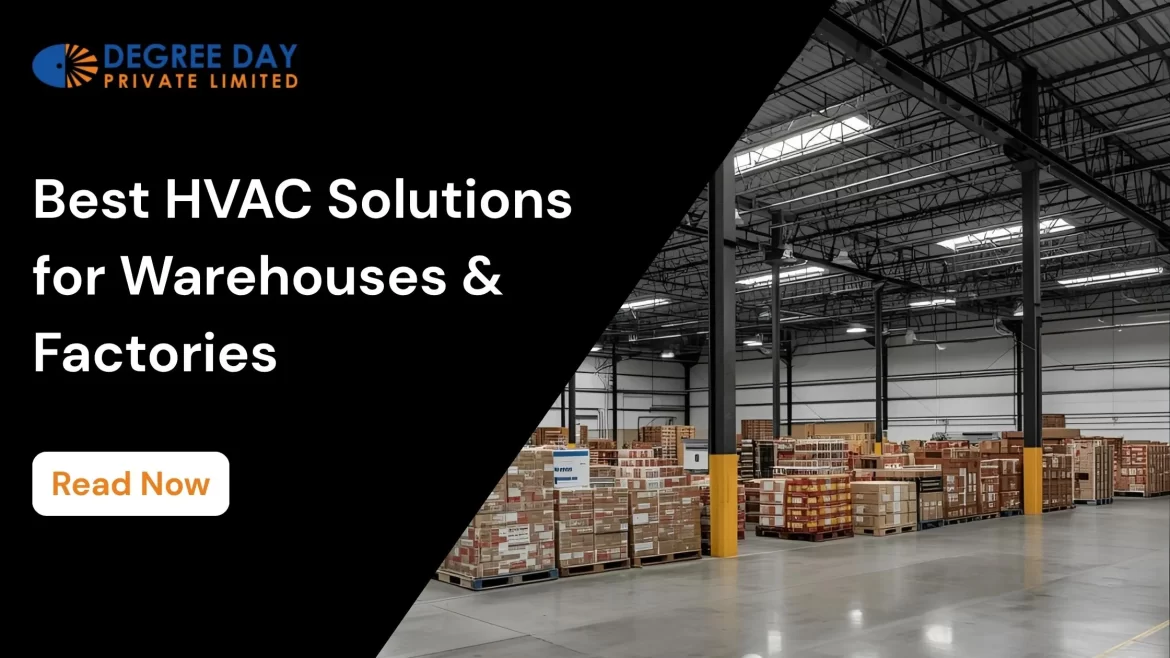Running a warehouse or factory in India’s climate isn’t easy. High ceilings, process heat, fluctuating occupancy, and seasonal humidity all make indoor comfort and energy efficiency a real challenge. Facility managers often face two big questions:
- How do I keep my workers comfortable without spending a fortune on energy?
- How do I protect sensitive products and processes with the right temperature and humidity control?
That’s where industrial HVAC solutions come in. From HVLS fans for destratification to AHUs for precise climate control, choosing the right setup depends on your building type, budget, and local climate, like Indore’s hot, semi-humid conditions.
Common HVAC Solutions for Industrial Spaces
| Solution | Best For | Main Benefit | Typical Equipment |
| High-volume low-speed fans (HVLS) | Large, high ceilings; general comfort | Energy-efficient air mixing; improved worker comfort | HVLS fans; controls |
| Evaporative cooling / Indirect evaporative | Dry or semi-humid climates; low-cost cooling | Very low operating cost; effective large-scale cooling | Pad media, blowers, indirect exchangers |
| Air handling units (AHU) with ducted supply | Conditioned storage, clean rooms, and offices | Precise temperature/humidity and filtration | AHU, filters, coils, ductwork, VFDs |
| Rooftop packaged units (RTUs) / packaged DX | Rooftop packaged units (RTUs) / packaged DX | Simple installation; modular | RTUs, condensing units |
| VRF/VRV systems | Offices, control rooms | Zoned control; high COP | Outdoor units, indoor FCUs |
| Spot/process cooling | Equipment or process zones | Localized control; reduces full-building load | Localized control reduces full-building load |
| Mechanical ventilation with heat/energy recovery (MVHR/ERV/HRV) | Buildings needing fresh air + energy recovery | Indoor air quality with reduced energy loss | ERV/HRV units, filters, controls |
How to Choose the Right HVAC System
Define your requirements: Calculate cooling load from products, equipment, and people. Decide tolerances for temperature, humidity, and IAQ.
1. Match solutions by priority
A. For precise climate control & filtration → AHU with ducts or VRF + AHU.
B. For worker comfort in large halls → HVLS fans + ventilation + spot cooling.
C. For the lowest energy cost in dry climates → Evaporative or indirect evaporative systems.
2. Optimize the building envelope: Improve roof insulation, seal openings, and add air curtains at loading bays.
3. Balance OPEX and CAPEX
A. Evaporative cooling and HVLS → low operating costs.
B. AHU/VRF → higher upfront investment but essential for sensitive storage or clean zones.
4. Think compliance & sustainability: Use low-GWP refrigerants, solar rooftops, and equipment that meets ISHRAE/ASHRAE guidelines.
Recommended HVAC Setups for Typical Industrial Scenarios
Large, high-ceiling warehouse
1. HVLS fans for destratification & comfort
2. RTUs or ductless splits for offices/shipping areas
3. Smart controls with CO2/temperature sensors
Distribution center with cold/temperature-sensitive storage
1. AHU with chilled water or packaged DX
2. Air curtains + insulated dock shelters
3. VFDs on pumps/fans for efficiency
Manufacturing plant with clean/process zones
1. Dedicated AHUs with MERV/HEPA filtration
2. Separate process chillers for equipment
3. Heat recovery from exhaust/process lines
Dry climate, low-budget option
1.Direct/indirect evaporative coolers
2. HVLS fans + night purge ventilation
Energy, Controls & Sustainability Tips
– Use building automation for scheduling, demand control ventilation, and motor VFDs.
– Recover heat from compressors/exhaust to preheat makeup air.
– Monitor energy KPIs remotely for predictive maintenance.
– Leverage solar rooftops to offset peak HVAC loads.
Maintenance & Vendor Selection
1. Commissioning: Verify design, airflow balance, and thermal performance before handover.
2. Maintenance: Regular checks for filters, belts, refrigerants, water treatment (evap systems), and fan bearings.
3. Vendor Criteria: Look for proven industrial experience, local service support, and lifecycle cost analysis (CAPEX + OPEX).
Read Benefits of Regular Maintenance of HVAC Equipment
Frequently Asked Questions (FAQs)
For comfort and energy savings, HVLS fans + evaporative cooling are best. For sensitive products, an AHU or VRF system is more suitable.
Yes, in dry or semi-humid climates. They offer large cooling capacity at a fraction of the cost of traditional air conditioning.
Focus on evaporative coolers, insulation, HVLS fans, VFDs on motors, and renewable power like solar rooftops.
The best HVAC solution for your warehouse or factory depends on your process requirements, building type, and local climate. Whether you need simple comfort cooling or precise cleanroom conditions, the right mix of HVLS fans, evaporative systems, Air Handling Units, or VRFs can balance comfort, energy efficiency, and long-term reliability.
Looking for a tailored HVAC system in Indore or anywhere in India? Degree Day Pvt. Ltd. specializes in energy-efficient industrial cooling.

